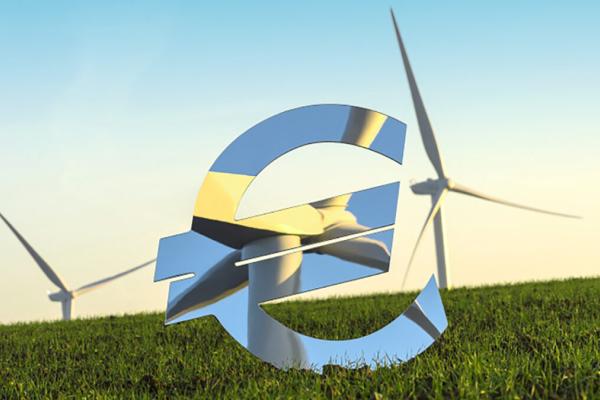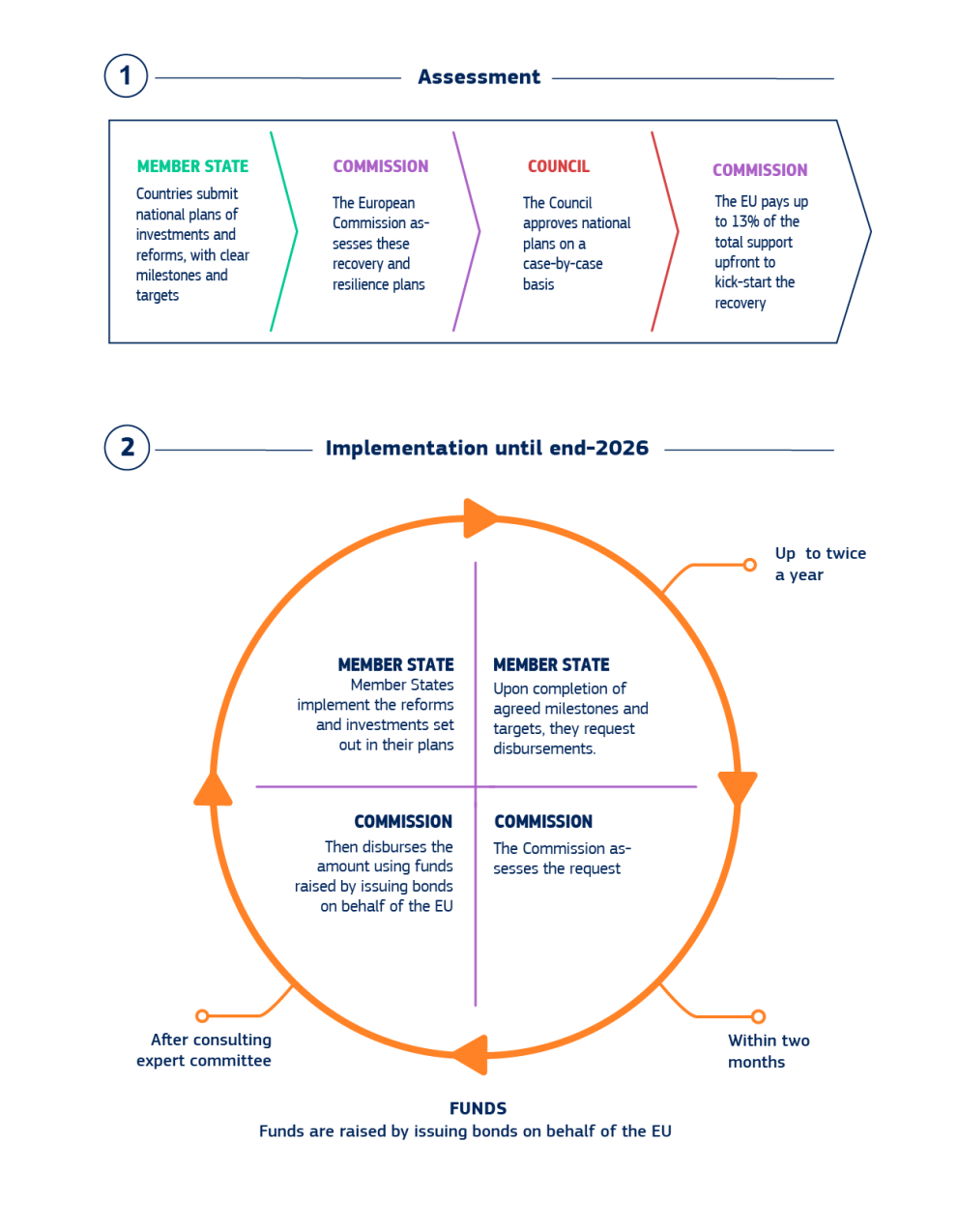Recovery and Resilience Facility
Summary
Budget
Official information source
https://commission.europa.eu/business-economy-euro/economic-recovery/recover...Description
The Recovery and Resilience Facility
The Recovery and Resilience Facility is the key instrument at the heart of NextGenerationEU to help the EU emerge stronger and more resilient from the current crisis.
The Recovery and Resilience Facility
The Recovery and Resilience Facility (RRF) is a temporary instrument that is the centrepiece of NextGenerationEU -the EU’s plan to emerge stronger and more resilient from the current crisis.
Through the Facility, the Commission raises funds by borrowing on the capital markets (issuing bonds on behalf of the EU). These are then available to its Member States, to implement ambitious reforms and investments that:
- make their economies and societies more sustainable, resilient and prepared for the green and digital transitions, in line with the EU’s priorities;
- address the challenges identified in country-specific recommendations under the European Semester framework of economic and social policy coordination.
The RRF is also crucial for implementing the REPowerEU plan – the Commission’s response to the socio-economic hardships and global energy market disruption caused by Russia's invasion of Ukraine.
€648 billion* to invest in reforms and projects at 2022 prices, of which €357 billion of funds in grants, €291 billion of funds in loans
*With the amended RRF Regulation, additional grants under the Emissions Trading System (ETS) and Brexit Adjustment Reserve (BAR) have been made available to Member States. Therefore, the EUR 357 billion in grants is now split in EUR 338 billion of original RRF grants, EUR 17.3 billion in ETS grants and EUR 1.6 billion in BAR grants. Furthermore, Member States could request loan support until August 2023. Of the total available envelope of EUR 385 billion, close to EUR 291 billion has been committed by end 2023. These two changes (more grants available through ETS and BAR and less loans requested than the total available envelope) result in a total RRF envelope of EUR 648 billion by end 2023. The previously mentioned amount of EUR 723 billion represented the maximum amount of RRF grants (EUR 338 billion) and RRF loans (EUR 385 billion) according to the RRF Regulation.
How does the Recovery and Facility work?
Implementation phase
- When they have completed the agreed milestones and targets, governments request payment (up to twice a year).
- The Commission assesses these requests for payment to check that the milestones and targets have been fulfilled. If so, it disburses the amounts it has raised on the capital markets.
Amendments
Member States can revise their plans based on the available legal grounds under the RRF Regulation. The Guidance on Recovery and Resilience Plans in the context of REPowerEU of February 2023 describes in detail how Member States can request such amendments.
A revision can be linked to financial aspects, that is:
- to benefit from additional REPowerEU funds;
- to reflect a change in a Member State's maximum financial allocation under the RRF;
- resources needed in order to take up additional RRF loans.
Member States can also amend their plan if they can demonstrate that objective circumstances render the implementation of certain milestones and targets unfeasible. For example, those objective circumstances could be linked to inflation, shortages in the supply chain or the fact that there is a better alternative to fulfil the intended policy objective of a measure.
Mid-Term Evaluation
The RRF Regulation requires that the Commission provides the European Parliament, the Council, the European Economic and Social Committee and the Committee of the Regions with a mid-term evaluation on the implementation of the Recovery and Resilience Facility. This will be followed by an 'ex post evaluation' in 2028, once the measures included in the recovery plans are fully implemented.
- Press release
- General factsheet
- Summary of the RRF Mid-Term Evaluation
- REPowerEU factsheet
- Country snapshots – February 2024
- How the RRF supports businesses

The REPowerEU plan recognised that the Recovery and Resilience Facility can play an important role in achieving secure, affordable and clean energy. By providing additional EU funding, the Facility will help EU countries make the critical reforms and investment needed to rapidly end their dependence on Russian fossil fuels.

Starting from its 2022 cycle, the European Semester process was adapted to take into account the creation of the Recovery and Resilience Facility and the implementation of the recovery and resilience plans.

Recovery and Resilience Scoreboard
The Scoreboard gives an overview of progress in implementing the Facility and the national recovery and resilience plans.
Documents
Recovery and Resilience Facility
RRF Regulation
- General publications
- 12 February 2021
- Secretariat-General
Consolidated text of the Regulation establishing the Recovery and Resilience Facility
- General publications
- 12 February 2021
- Secretariat-General
Regulation establishing the Recovery and Resilience Facility
- General publications
- 10 February 2021
- Secretariat-General
Questions and Answers on the Recovery and Resilience Facility
Guidance documents
- General publications
- 3 March 2023
- Secretariat-General
Guidance on Recovery and Resilience Plans in the context of REPowerEU
- General publications
- 20 January 2021
- Secretariat-General
Guidance to Member States - Recovery and Resilience Plans - Part 1
- General publications
- 22 January 2021
- Secretariat-General
Guidance to Member States - Recovery and Resilience Plans - Part 2
- General publications
- 22 January 2021
- Secretariat-General
Annex to the Guidance to Member States on the Recovery and Resilience Plans: Tables for the template
- General publications
- 18 February 2021
- Secretariat-General
DNSH technical guidance, amended October 2023
Support figures
- General publications
- 1 September 2023
- Secretariat-General
Overview of Member States’ loan requests received by the Commission by 31 August 2023
- General publications
- 18 April 2023
- Secretariat-General
Overview of Member States’ intentions to request RRF loan support
- General publications
- 22 June 2022
- Secretariat-General
Updated Member States’ grant allocation based on Eurostat outturn data for 2020 and 2021
Reports
- General publications
- 19 September 2023
- Secretariat-General
Recovery and Resilience Facility Annual Report 2023
- General publications
- 1 March 2022
- Secretariat-General
Recovery and Resilience Facility Annual Report
- General publications
- 29 July 2022
- Secretariat-General
Recovery and Resilience Facility Review Report
- General publications
- 21 February 2023
- Secretariat-General
Communication Implementation of the Recovery and Resilience Facility
Other
- General publications
- 27 April 2023
- Secretariat-General
- General publications
- 16 May 2023
- Secretariat-General
Council conclusions on the recovery plan and multiannual financial framework for 2021-2027
REPowerEU
- General publications
- 3 March 2023
- Secretariat-General
Guidance on Recovery and Resilience Plans in the context of REPowerEU
- General publications
- 28 February 2023
- Secretariat-General
- General publications
- 18 May 2022
- Secretariat-General
Commission Proposal for a Regulation on REPowerEU chapters in recovery and resilience plans
- General publications
- 24 April 2023
- Secretariat-General
Questions and Answers on REPowerEU and on the revision of national recovery plans
- General publications
- 21 February 2024
- Secretariat-General
Recovery and Resilience Facility - REPowerEU Factsheet
Recovery and Resilience Plans: At the Heart of Financing REPowerEU
European Semester
The Recovery and Resilience Facility in your country
Member States use the funds provided by the Recovery and Resilience Facility to implement ambitious reforms and investment to make their economies and societies more sustainable, resilient and prepared for the green and digital transitions. Explore the pages below to find out about your country’s recovery and resilience plan and how it is being implemented.

These pages contain all relevant country-specific information, including the recovery and resilience plans, the Commission’s assessment of the plans as well as information on payments requested by the Member States and funds paid out by the Commission.

European Semester in your country
This section brings together the country-specific documents related to the European Semester, notably (i) country reports, (ii) national programmes on reforms and fiscal adjustment, (iii) the assessment of these programmes, (iv) country-specific recommendations by the EU, and (v) draft budgetary plans.
Map of projects supported by the Recovery and Resilience Facility
This map provides examples of reforms and investments supported by the Recovery and Resilience Facility in the different EU Member States. It is not an exhaustive database of projects supported by the Facility and will be regularly updated as the implementation progresses. The funding amounts shown reflect the initial cost estimates included in the national recovery and resilience plans.
All countries Austria Belgium Bulgaria Croatia Cyprus Czechia Denmark Estonia Finland France Germany Greece Hungary Ireland Italy Latvia Lithuania Luxembourg Malta Netherlands Poland Portugal Romania Slovakia Slovenia Spain Sweden























HomeZoom inZoom outFullscreenPrintDownload data files
Canary Islands
Guadeloupe
Martinique
Guyana
Réunion
Mayotte
Azores
Madeira
Webtools + © EC-GISCO + Leaflet | © OpenStreetMap © EuroGeographics © UN-FAO for the administrative boundaries | Disclaimer
Legend
Green transition
Smart, sustainable and inclusive growth
Social and territorial cohesion
Health and economic, social and institutional resilience
Digital transformation
Policies for the next generation
Legend description
Disclaimer
Other information
Recovery and Resilience Task Force
Informal expert group on the implementation of the Recovery and Resilience Facility
Inform EU network and communication requirements
Fight against fraud
The effects of NextGenerationEU on the EU’s real GDP (until 2024 in a high productivity scenario)

"Quantifying Spillovers of Next Generation EU Investment, Discussion Paper July 2021."
The Facility is structured around six pillars: green transition; digital transformation; economic cohesion, productivity and competitiveness; social and territorial cohesion; health, economic, social and institutional resilience; policies for the next generation.
"Six pillars of the Recovery and Resilience Facility”

Scoreboard
The Recovery and Resilience Scoreboard displays EU countries’ progress in implementing their recovery and resilience plans and shows common indicators to report on progress and evaluate the Recovery and Resilience Facility and the national plans.
How does it work?
The RRF entered into force on 19 February 2021. It finances reforms and investments in Member States from the start of the pandemic in February 2020 until 31 December 2026. To finance NextGenerationEU, the European Commission, on behalf of the EU, will borrow on the capital markets.
To benefit from the support of the Facility, Member States submit their recovery and resilience plans to the European Commission. Each plan sets out the reforms and investments to be implemented by end-2026 and Member States can receive financing up to a previously agreed allocation..
Each plan should effectively address challenges identified in the European Semester, particularly the country-specific recommendations adopted by the Council. It should also advance the green and digital transitions and make Member States’ economies and societies more resilient.
The Recovery and Resilience Facility is performance based. Fulfilment of agreed milestones and targets towards achieving the reforms and investments in the plans will unlock regular payment.
"From plans to implementation. The Recovery and Resilience Facility (RRF) – How does it work?"

Questions and answers on the Recovery and Resilience Facility
Close links to the European Semester
The recovery and resilience plans will drive the Member States’ reform and investment agenda for the years to come. The European Semester, with its broader scope and multilateral surveillance, will usefully guide and complement the implementation of the recovery and resilience plans.
For this reason, starting from its 2022 cycle, the European Semester process was adapted to take into account the creation of the Recovery and Resilience Facility and of the implementation of the recovery and resilience plans:
- Country reports were streamlined. In terms of content, they provide an overview of the economic and social developments and challenges that Member States are facing, as well as a forward-looking analysis of their resilience. Based on this analysis, the 2022 country reports identify those challenges which are not sufficiently addressed by the recovery and resilience plans.
- Country-specific recommendations: together with the country reports, the Commission proposes to the Council country-specific recommendations (CSRs). The CSRs address the key issues identified in the country reports, and where relevant the in-depth reviews, for which policy action will be required. The CSRs also include recommendations on the budgetary situation of the Member States as envisaged under the Stability and Growth Pact.
- The national reform programmes (NRP) play a dual role. Besides their role in the context of the European Semester, the NRPs will also fulfil one of the two bi-annual reporting requirements of Member States under the Recovery and Resilience Facility.
The European Semester and Recovery and Resilience Facility processes are now integrated as illustrated below:

The European Semester in the time of the Recovery and Resilience Facility
More information on the European Semesterr
The country reports, the in-depth reviews and the proposals for CSRs form part of the yearly European Semester Spring package.
The CSRs proposed by the Commission in the context of the 2022 European Semester Spring Package also identify for each Member State which action should be taken in light of the current energy challenges, in the context and in line with the Commission’s REPowerEU proposal.
National recovery and resilience plans
The flags below will guide you to the Member State section. The links contain all relevant country-specific information, such as the recovery and resilience plans and key points about them, and where available, the legal texts approving the plan and accompanying press material.
Belgium
Belgium’s recovery and resilience plan
RRF-supported projects in the Member States
The map below provides examples of projects (reforms and investments) supported by the RRF in the different Member States. It contains a brief presentation of the projects, focusing on the concrete state of implementation and the next steps. It also redirects to more detailed information currently available online. The map exclusively serves information purposes and is not an exhaustive database of projects supported by the Recovery and Resilience Facility. The showcase of the projects is without prejudice to any future assessment by the Commission in the context of the verification of the satisfactory fulfilment of milestones and targets pursuant to Regulation (EU) 2021/241 of the European Parliament and of the Council establishing the Recovery and Resilience Facility.
The map is a living document that will be regularly updated. In particular, the map will incorporate information on the 100 biggest recipients of RRF funds in the different Member States, when this becomes available later this year, and information provided by Member States in the context of the future assessment of payment requests under the Recovery and Resilience Facility.
The Recovery and Resilience Task Force
In August 2020, the European Commission established the Recovery and Resilience Task Force (RECOVER) within its Secretariat-General. Jointly with the Commission’s Directorate-General for Economic and Financial Affairs, RECOVER is responsible for steering the implementation of the Recovery and Resilience Facility. RECOVER also coordinates the European Semester and reports to Commission President Ursula von der Leyen.
Documents
Communication Implementation of the Recovery and Resilience Facility
Guidance on Recovery and Resilience Plans in the context of REPowerEU
Recovery and Resilience Facility Review Report
Updated Member States’ grant allocation based on Eurostat outturn data for 2020 and 2021
Commission Proposal for a Regulation on REPowerEU chapters in recovery and resilience plans
Recovery and Resilience Facility Annual Report
Regulation establishing the Recovery and Resilience Facility
Guidance to Member States - Recovery and Resilience Plans - Part 1
Guidance to Member States - Recovery and Resilience Plans - Part 2
Annex to the Guidance to Member States on the Recovery and Resilience Plans: Tables for the template
‘Technical guidance on the application of “do no significant harm”
Council conclusions on the recovery plan and multiannual financial framework for 2021-2027
Country-specific recommendations 2022
Country-specific recommendations 2020
Country-specific recommendations 2019
Future Annual Events
The Commission organises together with Member States joint Annual Events, which constitute a key communication moment bringing together institutions, stakeholders (in particular social partners and civil society) and beneficiaries of RRF support to discuss the progress and state of play of the RRP implementation.
More information on the Annual Events that already took place can be found on the Recovery and Resilience Scoreboard.
The next confirmed Annual Events are listed below (the list will be updated regularly):
- Luxembourg: 17 April. For further information, please consult the dedicated website or contact the Representation of the Commission to Luxembourg
Fight against fraud
Fight against fraud is a priority for the European Commission. If you are aware of an act of fraud, please report it to the European Anti-Fraud Office.

